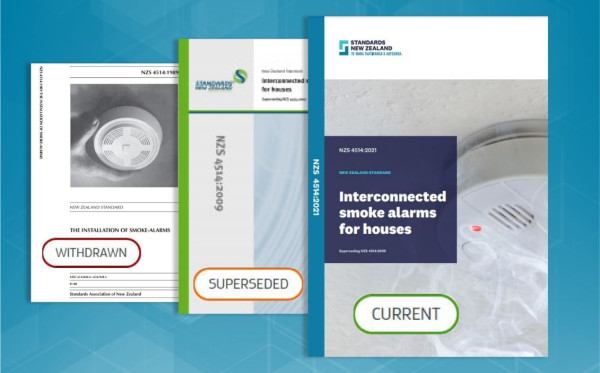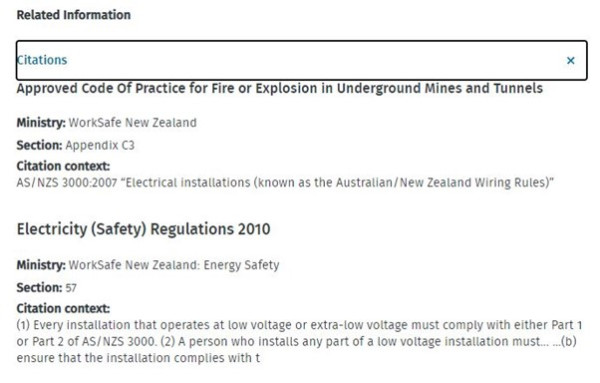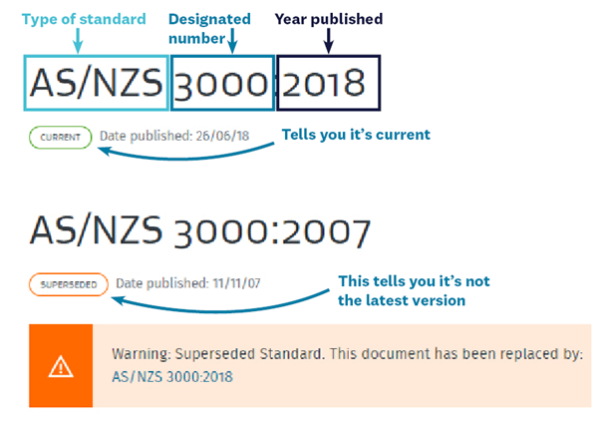Current, cited, superseded or withdrawn – which standard should you use?
Standards New Zealand provides access to over 140,000 international, joint Australian/New Zealand and New Zealand standards and related documents. This massive online collection is made up of current, superseded and withdrawn versions of standards, some of which may be cited.

A range of similar standards showing their status
The answer depends on what is the standard and context you are using it in. Let's look at what each label means:
Current
This is the latest version, and even if this is ten years old or more, if there has not been a revision since, it remains the most up to date version of that standard.
Superseded
This will not be the latest version of the standard, meaning that the standard has been revised and there is a newer version. We constantly review standards that are more than 10 years old to ensure they are current and continue to be fit for purpose and you can help determine their future through public consultation.
Withdrawn
The last version of the standard did not go through a further revision and is now decommissioned – while the good practice or guidance the standard may have provided at the time was relevant, it may no longer be useful or relevant for today’s needs, nor reflect technological advances. There will be no superseding standard for withdrawn standards.
Cited
This means following the standard, or part of it, is a requirement under law and referenced either in regulation, Acts, or policy. Standards may even be cited or referenced in other standards. Both superseded and withdrawn standards may be cited – here a requirement or guidance may need to point towards good practice of the time when the standard was relevant and before it was withdrawn or superseded. There may sometimes be a gap between when a new standard becomes available and when it replaces its predecessor wherever it may be cited, for example when it is cited in legislation and the relevant Act needs to go through a process to be updated.
Examples of where standards may be cited include:
- Referenced in Acts or regulations as legally mandatory.
- Referenced in Acts or regulations as ‘acceptable solutions’ or ‘means of compliance’. This ensures compliance with legislation but does not prevent the use of an alternative method, provided it meets the specified legislative criteria, for example the New Zealand Building Code.
- Used by a government agency to detail a required condition of contract with an external supplier.
- Incorporated into non-regulatory material as examples of leading practice or guidance for industry.
- Employed as a means of compliance with industry regulation, for example, specifying requirements for audit certification.
- Promoted as a means of dealing with legal liability issues, for example, compliance with various risk management standards may be cited in court as proof that all reasonable steps were taken.
How to know if a standard is cited
You can see instantly if a standard is cited from this symbol below its name in the webshop:

The cited symbol seen under the standard listing
You can also find this information as a dropdown option on the webpage for the relevant standard:

This example shows the superseded AS/NZS 3000:2007 version which is referenced throughout multiple WorkSafe New Zealand documents.
De-jointed standards
There may be occasion when a former Australian/New Zealand (AS/NZS) joint standard is either superseded or withdrawn in either Australia or New Zealand. The ongoing version therefore only remains current within the one country that will continue to keep the standard up to date.
Why old standards remain available
You may find you need to refer to withdrawn or superseded standards if the information it contains is relevant to understand how it was applied historically. That’s why we continue to provide withdrawn and superseded standards.
As the guardians of standards we want those who might need to refer to old standards to have the choice and access. Some users need to compare one version to another and again providing access to withdrawn standards supports this.
How to know if it’s the latest version
Every standard comes dated. If it has a green ‘current’ badge below you know it’s the latest version.
Any standards that have been superseded will have a warning box beneath the name informing you of this.

How to determine type, publication year and status of a standard.
Protecting the legitimacy of good practice
Standards New Zealand’s role goes beyond standards development – we are also guardians protecting copyright, providing access and updating reference to citations where they apply. While any organisation can produce their own ‘standard’, with Standards New Zealand as kaitiaki maintaining the integrity of the New Zealand, joint Australian/New Zealand and international standards, you can be confident what you are using is as agreed by the experts that put it together, legitimate and true.
Good practice doesn’t stop once a standard is developed. Standards reflect both the micro and macro environment they are used in. With continual technological and scientific advances and changes in policy and operating environments, standards will continue to evolve and new ones emerge to reflect the changing world.
